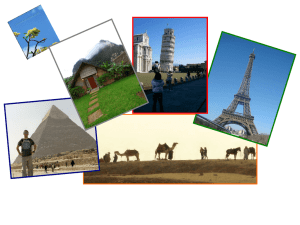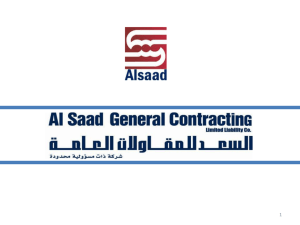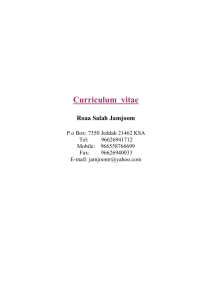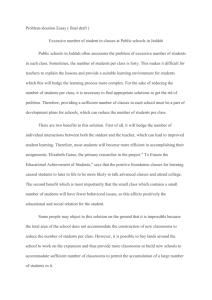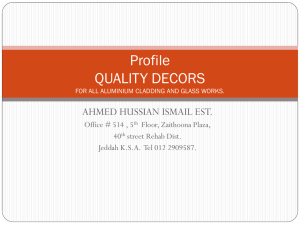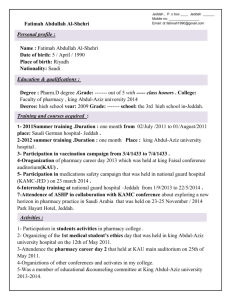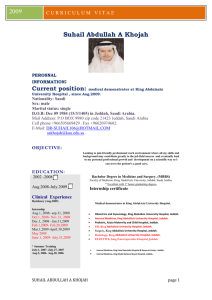25547
advertisement
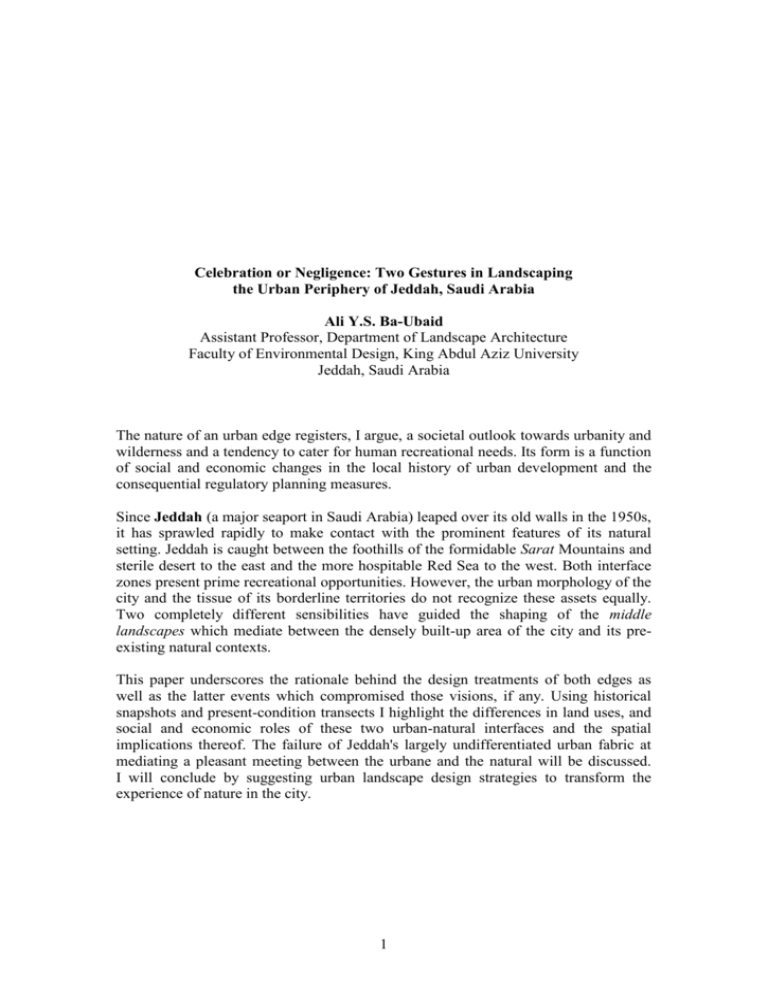
Celebration or Negligence: Two Gestures in Landscaping the Urban Periphery of Jeddah, Saudi Arabia Ali Y.S. Ba-Ubaid Assistant Professor, Department of Landscape Architecture Faculty of Environmental Design, King Abdul Aziz University Jeddah, Saudi Arabia The nature of an urban edge registers, I argue, a societal outlook towards urbanity and wilderness and a tendency to cater for human recreational needs. Its form is a function of social and economic changes in the local history of urban development and the consequential regulatory planning measures. Since Jeddah (a major seaport in Saudi Arabia) leaped over its old walls in the 1950s, it has sprawled rapidly to make contact with the prominent features of its natural setting. Jeddah is caught between the foothills of the formidable Sarat Mountains and sterile desert to the east and the more hospitable Red Sea to the west. Both interface zones present prime recreational opportunities. However, the urban morphology of the city and the tissue of its borderline territories do not recognize these assets equally. Two completely different sensibilities have guided the shaping of the middle landscapes which mediate between the densely built-up area of the city and its preexisting natural contexts. This paper underscores the rationale behind the design treatments of both edges as well as the latter events which compromised those visions, if any. Using historical snapshots and present-condition transects I highlight the differences in land uses, and social and economic roles of these two urban-natural interfaces and the spatial implications thereof. The failure of Jeddah's largely undifferentiated urban fabric at mediating a pleasant meeting between the urbane and the natural will be discussed. I will conclude by suggesting urban landscape design strategies to transform the experience of nature in the city. 1 A MOSAIC OF LINES Jeddah is situated in a narrow coastal plain along the eastern shoreline of the Red Sea. It owes its existence to a few gaps in the formidable line of mountain ridges east of the city and a series of corresponding breaks in the intricate line of the coral reef fringing the Red Sea shore. The linear form of the city's urban built-up area reflects vividly the basic landscape units that articulate this confined stretch of coastal desert. Most important of these natural and man-made lines are (1) the visible line of wave break at the point where the coral limestone platform plunges down under water; (2) the coastal promenade with its many elongated lagoons; (3) the several north-south arterial thoroughfares; (4) the freeway that once hemmed the city and constituted its eastern edge; as well as (5) the patches of desert sprinkled amongst chains of easterly hills, respectively from west to east. Though generally flat, the littoral land in Jeddah region rises eastward gradually to approximately 40-60 meters above sea level before it meets the barren foothills of the basaltic mountains. The twelve-kilometer wide Tihama plain is traversed, in an eastwest direction, by some eleven deep wadis. Though overrun by urbanization, the courses of these old dry valleys persist by their associated erosional cuts, beds of silt and clay deposits, and the deep indentations into the coastline where wadi mouths form bays and creeks. These water courses become particularly visible within the city following a torrential rain. WATER AS LIMITING FACTOR Jeddah was founded as a fishermen's community in the sixth century. For centuries, it maintained a small footprint beset by treacherous salt marshes (known locally as sabkhas), extensive tidal flats, and a formidable desert. Until the 1930s, the hexagonal fortifications ringed an area less than 0.81 square kilometer (0.32 square miles). The community's modest size was instrumental—historically speaking—to Jeddah's survival. Jeddah residents balanced their aspirations for prosperity with their hinterland's limited resources. Jeddah was surrounded by a constellation of villages and early rural enclaves. Some fulfilled economic occupations that augmented Jeddah's niche in the regional economy, as a trade center and transportation node. Farmlands, fishing hamlets, and cattle herding posts dotted the landscape. Paths lead out from the old town's five gateways to such sites. Being in a desert, water was the chief limiting factor. Urbanites needed to go far a field into the desert looking for water sources, harvest it, channel it underground, and then store it in a cistern somewhere closer to home. This—originally Persian— technique to obtain water was the basis for the invisible lines that coupled the livelihood and economies of city and country. 2 Naturally, the costly enterprise was something for the well-to-do to undertake. Over the centuries, many wealthy families helped tap wells and springs in the country and build a tremendous network of water supply lines to convey potable water to city residents. These lines ran alongside the many wadis crossing the region. The affluent also built rural and suburban estates near headwaters or along water conduits outside the city. These lavishly landscaped retreats were outposts staking out the desert for future settlement. The intense effect of these sites on the collective memory of city residents is registered in the names of city neighborhoods and streets today. SIGNIFICANT BREAKTHROUGHS Early Planning Phase (1951-1970) A succession of improvements in waterworks helped Jeddah deal with acute resource scarcity yet without undermining the very base on which the lives of villagers in the catchment area depend. This reciprocity between city and country, however, suffered a setback around the middle of the twentieth century. In 1974, the city's fortification came down, paving the way for unprecedented urban growth. Around the same time, the state completed 'Ain al-Azizeyyah, a 60-km long water conveyance line that doubled the amount available to city residents. Aquifers in wadi Fatimah (east) and wadi Khulays (northeast) supplied some 650,000 gallons of water a day, eight times what was available prior to the demolition of the city wall. Consequently, in the two decades following World War II, Jeddah's population increased eleven folds, from a quaint town of 25,000 people to a thriving city of nearly 350,000 residents. By 1996, the city's population stood at over 1.6 millions. Expansion in the 1950s and 1960s advanced eastward in the direction of the aforementioned water supply line. Suitable land for development was quickly consumed. Flood-prone land to the north, marshes to the west, and the foothills to the east constrained the space available to urban development and constituted the ruralurban interface. Former outposts and suburban enclaves became the nuclei of elegant residential quarters. Some transformed into public gardens. Also, princely palaces and grand villas for the newly emerging technocrat class sprang up along the route leading east from the old city. At this point, the waterfront along the Red Sea, however, was not envisaged as an open space system with great potentials for development. Late Planning Phase (1970-Present) The excessive withdrawal of water at unsustainable rates was exacerbated by erratic precipitation and sometimes rainless seasons in the hinterland. Agriculture declined and desertification picked up the pace, forcing more rural residents to migrate to the city in search of better life standards. Nonetheless, the adverse effects of this were greatly mitigated by massive public spending. 3 Seawater desalination was just the technology Jeddah needed to keep on growing. The first of six desalination plants became operational in 1970. Its site was 10 km north of the old town, on a spot favored by Jeddah's weekend picnic-goers. The increase in the output of desalination plants to seventeen folds in merely ten years indicates the serious dependence on it as a source. At last, flood-prone land north of the old city became developable after stormwater ditches were constructed to intercept and divert the dangerous run-off in the immediate surrounds of the expanding city. Furthermore, city authorities executed a massive sea reclamation program beginning with the waterfront of the downtown area. The program was quickly and ambitiously expanded to give a face-lift to the entire length of the city-sea interface. Roads soon linked this newly-opened frontier to the old core and intense real estate speculative activity energized demand. On the other hand, high levels of automobile ownership and a growing preference for single family villa-type residences permitted a more scattered form of urban development. Overall, the economic upturn reinforced the drive for development but its pattern has changed and the axis along which it was to march has also shifted. TWO DIFFERENT EDGE CONDITIONS Two moments in time helped shape two distinct urban edge conditions for Jeddah. Each edge dominated under a specific planning paradigm.1 When layers of history are peeled off, the city-desert edge relates the dynamics of the earlier phase of urban growth and city planning. Meanwhile, the city-water edge reflects the post-1980s dramatic shift in the planners' and society's perception of the sea and the city's relationship to it. The resultant urban edges can be thought of as the layers containing the city region, and as such each is a zone of intense interaction. Its dynamic state reveals societal transitions. While embodying a plan's vision it constantly reacts to changes in the prevailing economic doctrine. As the vision falls out of sync with the pragmatic realities on the ground, the interface quickly experiences fragmentation and yields dysfunctional associations. In the case of Jeddah, the desert edge was first to show symptoms of illness. This fringe tier is environmentally degraded, visually unappealing, and economically underutilized. The sea edge has come under pressure only recently. The current trend towards generating revenue utilizing capital assets built by the city—particularly in the area of promoting waterfront tourism—has led to mass surrender of a an invaluable public open space to privatized investments. 1 The author recognizes two principal phases in the planning of the city. The first wave of growth was envisioned by consultant A. Makhlouf, between 1951 and 1966. The second phase of immense growth was governed by two plans: the 1973 Matheo-Marshall's and the 1980 Sert JacksonSaudConsult revision. 4 THE DESERT & THE FOOTHILLS The major south-north expressway east of the city is the key divide along which the city edge was "meant to be." Because of this, the city has traditionally relegated this zone to unsightly and polluting land uses. Virtually, every single activity that is a prerequisite for urban living but not attractive enough to have it in any one's neighborhood happens on the desert side of the freeway. Extractive industries are a major land use, including soil stripping operations and building material quarrying (Figure 1). Heavy industries and warehousing are also common. The city's largest livestock and cattle folds are located directly off a major highway intersection. Also, recycling activities are especially important polluters of desert land along the city edge. They include a reservoir of untreated sewage, two sanitary landfills, and numerous salvage yards (Figure 2). In addition, the desert is crisscrossed by many utility corridors and unattractive urbanizing features like pylons. There is an intermingling of low to medium-density housing amidst all of this. Steep hillsides are blanketed with squatter settlements lived in by recent immigrants to the city. The area is poorly serviced and in many cases lacks access to basic water and sanitation. Nonetheless, many tracts are developed as planned subdivisions featuring a gridiron pattern of streets with streetscape identical to what exists in other sections in the city proper. Numerous rural settlements were either overrun or encircled by urban development. Occasionally, signs of the history of the place may have endured and are very much worth preserving. Manholes for the supply lines along Wadi Ghulayl, old working farms, riprap stone walls and retention dams, a small number of die-hard mud structures in the vernacular style can all still be seen in various places within this fringe zone. Figure 1 Figure 2 5 The industrial quality of this edge landscape is unmistakable. The pristine nature of the landscape has been eradicated in most places. Remnant patches of scrubby vegetation exist in headwaters but in the floodplains, they are degraded severely by uncontrolled development. Native wildlife habitats are disturbed but some migrating bird species and pets have found suitable niches in the new man-made ecosystems. Some impenetrable areas remain lightly disturbed and are underutilized but the lack or the prohibitive cost of providing infrastructure may thwart efforts to realize their full recreational potential. Other sites should remain off-limits for sometime even if they were to receive some treatment in order to prepare them for a suitable 'soft' end use.2 THE SEA & THE CORNICHE Here too, a path is the center of this lateral reference. But the similarities end there. It is here where the desert city finally meets a different biome. The edge is marked further by a series of lines: dead coral platform, tidal range, deposits, the hard edge, the road, ribbons of backwaters, and the first row of buildings (Figure 3). Urban development along and within a few hundred meters from this edge is the city's most trendy. The initial flight northward out of the old core was pioneered by the bourgeoisie, foreign embassies, gated compounds, and royal palaces. Marshes and bays along the flat coastal plain were either filled up for building purposes or dug up to form artificial lagoons at a great cost. The oversized building lots received luxurious free-standing residences engrossed within lush gardens. Buildings are built up to high design standards and with a definite sense of self-expression. The Corniche strip is, indeed, the ultimate landscape of consumption. Figure 3 The former scatterings of favorable spots for picnicking and water-based sports along the 90-km shoreline were joined into a sinuous promenade with unlimited recreational opportunities. The Corniche (as it is locally referred to) was a major undertaking, setting aside a strip of land along the shoreline for public good and recreational land 2 Passive open space and outdoor recreation areas are examples of soft end uses. The natural ways to recover sites for such uses constitute an alternative to intensive landscape and ecological restoration aimed at preparing the land for housing and commercial development. 6 use. While skirting the westernmost edge of the city, the promenade avoids important sea edge land uses such as the port, desalination plant, a refinery, and the King's Palace. The intensity of activities alongside the Corniche makes it a very penetrable edge element. The fact that prominent features of the edge are visible from many positions within the adjacent urban fabric of the city provides general directional orientation and further connects the city and the sea edge. Figure 4 The Corniche is the pride of present day Jeddah, an important leisure facility that attracts visitors from a large catchment area. It is a hard-edged man-made promenade dividing land from the sea and incorporating attractions for the local population. Ironically, rocks for the sea edge came from the desert edge: they were obtained from lava flows which cover the easterly hills. The meandering carriageways are divided by artificial lagoons. They frequently intersect at many sculptured roundabouts which act as point references. Along the landward side of the road a wide array of facilities are lined up such as theme gardens, luxury hotels, funfairs, sculpture gardens, and open-air cafes. On the seaward side, mosques, restaurants, chalets for rent, amusement parks, and marinas (Figure 4). LANDSCAPES OF WORK & PLAY Jeddah today is confined between two edges. The water edge along the sea shoreline is dedicated for the utter pursuit of pretentious consumption and recreation. The desert interface, however, is the domain of repulsive production and refuse disposal, a wasteland. The divergence between the two different boundary zones reveals a resource imbalance and a tense social polarization. Urban edge landscapes are nicely situated to best exhibit environmental inequality and social ills. In rebuilding the links between the city and its environs—across this threshold zone—one must seek to better understand both the physical and social forces involved so as to address them concurrently. Nature's processes interconnect and overlap but rarely run in parallel. The same is probably true about urban human ecology. Streamlined city plans whose goal is to elude conflict by minimizing human interaction are likely to generate a disjointed and 7 unsustainable social and built environment. Likewise, real world forces tending to separate the domain of work from all other life departments, or those bent on pushing the poor out to poorly-serviced areas on the periphery must be reckoned with. The polarization they engender, like all dichotomies, is Gradient, as opposed to abrupt transition, from urban core to sub-urban periphery imparts cohesiveness to the urban fabric and enriches the urban experience by adding variety and meaning to it. Natural processes pervading the urban area is offers a handy framework to achieve desirable continuities. For the case at hand, I advocate protecting and creating natural and man-made green corridors to reconnect the city core with its hinterland. The basic network of wadis which dissect the city from east to west promises to lend the city the needed quality of ecological coherence. Once these wadi courses are restored, a greenway system transcending the differences between urban core to suburban fringe and wider hinterland will be in place. It will bridge the gap between the desert-edge and the seaedge and simultaneously, will underscore the reality that "…the richest coral reefs in the world exist alongside one of the most arid and inhospitable desert in the world."3 Wadis will act like green 'thoroughfares' penetrating the city's built-up area. The many edge conditions they will prompt will increase diversity and ecological resilience. Recasting the form and function of both fringe areas and inner cities along ecological lines will yield tangible environmental improvements throughout the city. Opportunities for experimenting with alternative forms of development and land management in addition to facilitating informal leisure with education are amongst just examples. Finally, a comprehensive open space plan must begin at the regional level and proceed downward. But for this to be meaningful, administrative boundaries should be drawn in tandem with ecological determinants. The functional and formal differences between core and edge sections of the city makes it necessary to redraw jurisdiction boundaries so as to delineate the zones appropriately and enable decisionmakers to bend the codes and planning bylaws wherever need be. 3 Edmund Waller, Landscape Planning in Saudi Arabia, Singapore: Shani Publications, 1991, pp.69. 8 REFERENCES Ahem, J. "Greenways as a Planning Strategy." Landscape and Urban Planning 33 (1995): 131-155. al-Hathloul, S. and M. Mughal. "Jeddah: A City Profile." Cities (November 1991): 267-275. Bokhary, A.Y. Jeddah: A Study in Urban Formation. Ph.D. Dissertation. University of Pennsylvania, 1978. Daniels, Thomas and Mark Lapping. "The Two Rural Americas Need More, Not Less, Planning." Journal of the American Planning Association 62 (1996): 285-289. Donaldson, Scott. "City and Country: Marriage Proposals." American Quarterly 20 (Fall 1968): 547-566. Friedberger, Mark. "The Rural-Urban Fringe in the Late Twentieth Century." Agricultural History 74(Spring 2000): 502-514. Italconsult. Water Supply Survey for the Jeddah-Makkah-Taif Area, Final Report. Riyadh: Ministry of Agriculture and Water, 1969. Jeddah Municipality, Jeddah: A Changing Ecosystem. Jeddah: Jeddah Municipality, 1980. Jenks, Mike and Rod Burgess, eds. Compact Cities: Sustainable Urban Forms for Developing Countries. London, UK: Spon Press, 2001. Linehan, J., M. Gross, and J. Finn. "Greenway Planning: Developing a Landscape Ecological Network Approach." Landscape and Urban Planning 33 (1995): 179-193. Ling, Chris. “Rebuilding the Post-industrial Landscape: Interaction between Landscape and Biodiversity on Derelict Land.” In Proceedings of the Conference on Multifunctional Landscapes: Interdisciplinary Approaches to Landscape Research and Management. Roskilde, Denmark, Oct 2000. Lynch, Kevin. The Image of the City. Cambridge, MA: The MIT Press, 1979. Sert Jackson Int./SaudConsult. Technical Report No. (9): Amended and Updated Master Plan. MOMRA, Jeddah Planning and Development Department, 1980. Spirn, Anne Whiston. The Granite Garden: Urban Nature and Human Design. New York: Basic Books, 1984. Waller, Edmund. Landscape Planning in Saudi Arabia. Singapore: Shani Publications, 1991. Wood, Robert and Joe Ravetz. "Recasting the Urban Fringe." Landscape Design (October 2000) 13-16. 9
